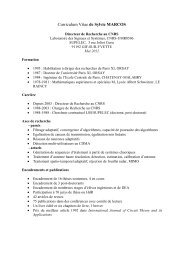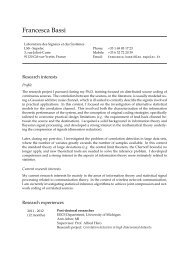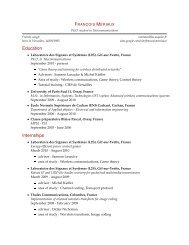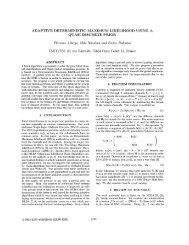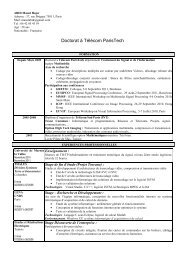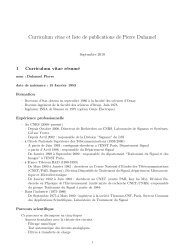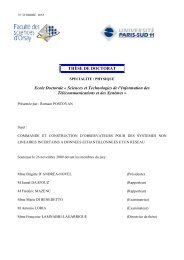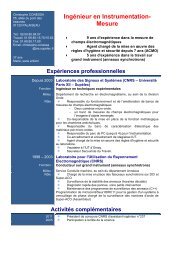Journée des doctorants - Laboratoire des signaux et systèmes
Journée des doctorants - Laboratoire des signaux et systèmes
Journée des doctorants - Laboratoire des signaux et systèmes
Create successful ePaper yourself
Turn your PDF publications into a flip-book with our unique Google optimized e-Paper software.
Résumés <strong>des</strong> interventions<br />
Mounir BEKAIK<br />
Thomas BOULAY<br />
Titre : Commande <strong>et</strong> observation de <strong>systèmes</strong> à r<strong>et</strong>ard variant dans le temps<br />
Directeurs de thèse : F. MAZENC - S. NICULESCU<br />
Date de début de thèse : 20/09/2010<br />
Bureau : B.3.39B<br />
Tél. : 01 69 85 17 26<br />
E-mail : Mounir.Bekaik@lss.supelec.fr<br />
Résumé : Ce doctorat sera centré sur deux objectifs principaux. Le premier sera la construction, pour <strong>des</strong> <strong>systèmes</strong> non linéaires<br />
possédant les caractéristiques mentionnées ci-<strong>des</strong>sus, de lois de comman<strong>des</strong> qui stabilisent globalement asymptotiquement uniformément<br />
leur origine. Par exemple, une première étape consistera à déterminer <strong>des</strong> comman<strong>des</strong> linéaires rendant globalement<br />
asymptotiquement uniformément stable l'origine d'une chaine d'intégrateurs de dimension 2 à coefficients variant dans le temps <strong>et</strong><br />
ayant un r<strong>et</strong>ard ponctuel constant dans l'entrée.<br />
La suite consistera à résoudre <strong>des</strong> problèmes similaires pour les familles de <strong>systèmes</strong> non linéaires générales <strong>et</strong> essentielles que<br />
constituent les <strong>systèmes</strong> de forme feedback <strong>et</strong> les <strong>systèmes</strong> de forme feedforward.<br />
Le deuxième objectif principal consistera à déterminer, d'abord pour <strong>des</strong> <strong>systèmes</strong> non linéaires à r<strong>et</strong>ard autonome, puis pour <strong>des</strong><br />
<strong>systèmes</strong> non linéaires variant dans le temps, d'un outil récent, appelé observateur par intervalle, qui perm<strong>et</strong> d'obtenir en chaque<br />
instant une estimée de la valeur de chaque composante d'une solution d'un système donné. Les travaux seront fait dans l'esprit<br />
<strong>des</strong> articles mais seront axés plus spécifiquement sur les difficultés de construction causées par la présence de termes non linéai<br />
res. La prise en compte de perturbations conduisant à <strong>des</strong> observateurs par intervalles possédant vis à vis de termes additifs <strong>des</strong><br />
propriétés de robustesse de type ISS sera un suj<strong>et</strong> clef.<br />
Ning CHU<br />
Titre : Application <strong>des</strong> GPU à la fonction NCTR Radar<br />
Directeurs de thèse : A. MOHAMMAD-DJAFARI - N. GAC<br />
Date de début de thèse : 01/10/2010<br />
Bureau : C.4.18<br />
Tél. : 01 69 85 17 43<br />
E-mail : Thomas.Boulay@lss.supelec.fr<br />
Résumé : Au cours <strong>des</strong> derniers conflits, les techniques d’identification coopérative de cibles ne se sont pas révélées toujours<br />
fiables <strong>et</strong> il s’avèrent de plus en plus que les techniques non coopératives, appelés NCTR (Non Cooperative Targ<strong>et</strong> Recognition)<br />
deviennent indispensables. Une <strong>des</strong> techniques possibles pour identifier une cible consiste à comparer la signature de la cible à<br />
identifier avec les signatures contenues dans une base d’apprentissage. Dans ce cas, on peut assimiler le problème NCTR à un<br />
problème de classification supervisé. Parmi ces métho<strong>des</strong>, on trouve la méthode <strong>des</strong> K Plus Proches Voisins (KPPV). C<strong>et</strong>te<br />
méthode va classer la cible dans la classe majoritaire parmi les K plus proches voisins. Le choix de c<strong>et</strong> algorithme par rapport à<br />
d’autres techniques, de type “Isomap” par exemple, est justifié par notre intention de ne pas compresser l’information <strong>et</strong> donc<br />
d’utiliser la puissance de calcul <strong>des</strong> GPUs pour étudier sur nos données les performances d’algorithmes de type “brute force”.<br />
Dans c<strong>et</strong>te thèse nous nous intéresserons aux problèmes de reconnaissance non-coopérative de cibles en tant que<br />
problème de classification supervisée. Nous utilisons pour cela un algorithme <strong>des</strong> KPPV dont les performances sont détaillées en<br />
fonction du nombre de voisins K, du type de distance utilisé <strong>et</strong> de l’espace de représentation <strong>des</strong> données. Dans un second temps,<br />
c<strong>et</strong> algorithme a été implémenté sur GPU. Les temps de calcul <strong>et</strong> de transfert mémoire ont été pris en compte pour évaluer<br />
l’apport de c<strong>et</strong>te implémentation.<br />
Titre : Robust Bayesian super-resolution approach via sparsity enforcing priors for near-field wideband<br />
aeroacoustic source imaging<br />
Directeurs de thèse : A. MOHAMMAD-DJAFARI<br />
Co-encadrants : J. PICHERAL (SSE, SUPELEC), N. GAC (L2S)<br />
Date de début de thèse : 01/10/2010<br />
Bureau : C.4.18<br />
Tél. : 01 69 85 17 43<br />
E-mail : Ning.Chu@lss.supelec.fr<br />
Résumé : Near-field wideband aeroacoustic imaging has been drawing great attentions of researchers and engineers on<br />
aeroacoustic source localization and power estimation over deca<strong>des</strong>. Recently the deconvolution-based m<strong>et</strong>hods, like the original<br />
DAMAS and its extensions, have greatly improved spatial resolutions of the conventional beamforming m<strong>et</strong>hod and became a<br />
breakthrough in aeroacoustic imaging. But neither the original DAMAS nor most of other classical m<strong>et</strong>hods are robust to<br />
background noise, or provide wide dynamic range of power estimation, particularly in the low Signal-to-Noise Ratio (SNR) situation.<br />
In my PhD studies, we first improve the forward model by considering background noise for near-field wideband uncorrelated<br />
sources. Then we propose a robust Bayesian super-resolution approach via sparsity enforcing priors to estimate source powers<br />
and positions in poor SNR case, and jointly estimate the variance of background noise and other model param<strong>et</strong>ers. Our approach<br />
is compared with some of the state-of-the-art m<strong>et</strong>hods on simulated, real data and hybrid data. The main advantages of proposed<br />
approach are robust to noise, wide dynamic range, super spatial resolutions, and not need for the prior knowledge of the source<br />
number or SNR. It is feasible to apply in near-field wideband monopole and extended source imaging based on the 2D non-uniform<br />
microphone array for wind tunnel test. For future works, we are investigating a more sophisticated and appropriate prior model<br />
(like Student prior) for coherent sources, colored noise and model param<strong>et</strong>ers (like Gamma Distribution), and applying hierarchical<br />
Bayesian inference approach and Variational Bayesian (VB) technique to effectively and adaptively estimate hyperparam<strong>et</strong>er in<br />
forward model and prior models.



